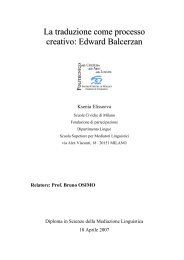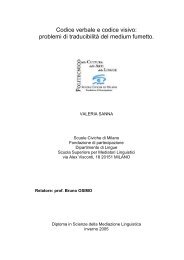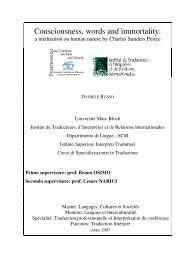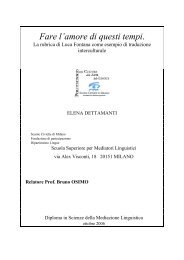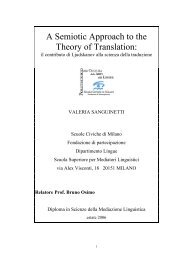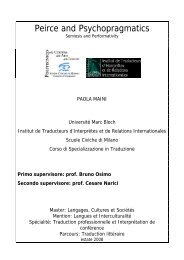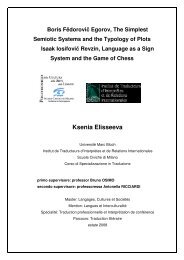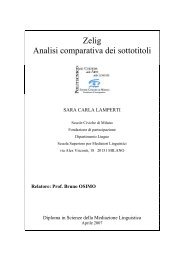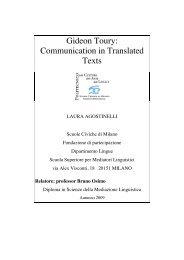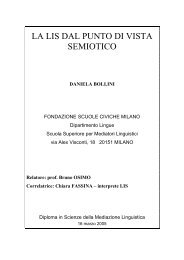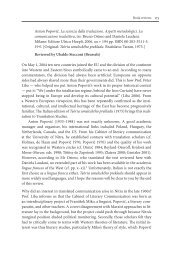Alice in Wonderland - Bruno Osimo, traduzioni, semiotica della ...
Alice in Wonderland - Bruno Osimo, traduzioni, semiotica della ...
Alice in Wonderland - Bruno Osimo, traduzioni, semiotica della ...
Create successful ePaper yourself
Turn your PDF publications into a flip-book with our unique Google optimized e-Paper software.
Bill is a lizard. His name is used <strong>in</strong> a pun <strong>in</strong> the very title of the chapter:<br />
THE RABBIT SENDS IN A LITTLE BILL. The majority of the translators skip<br />
this pun, except Bublitz (DE-BUB), who plays with Bill and billig (“cheap”),<br />
and the Spanish translator, who uses the dim<strong>in</strong>utive of Pepe, Pepito, which<br />
means “a little lump of meat.” Although it is not bits of meat but of cake<br />
that are sent <strong>in</strong> by the Rabbit, the pun will probably work for Spanish<br />
readers. Enzensberger’s solution (DE-ENZ) is <strong>in</strong> l<strong>in</strong>e with his general<br />
adapt<strong>in</strong>g strategy, but the name Egon seems completely unmotivated. This<br />
is a frequent problem with substitutions; once you have started, it is<br />
difficult to tell where to stop.<br />
Type names, i.e., typical names for certa<strong>in</strong> classes of objects, also refer to<br />
the real world of author and addressee because they are culture-specific.<br />
The only name of this k<strong>in</strong>d <strong>in</strong> <strong>Alice</strong> <strong>in</strong> <strong>Wonderland</strong> is Fury. S<strong>in</strong>ce this name<br />
appears <strong>in</strong> the Mouse’s tale where she justifies why she hates cats and dogs,<br />
a literal translation render<strong>in</strong>g the proper name by a generic noun (as <strong>in</strong> DE-<br />
ENZ, ES and IT) destroys the coherence between the context and the tale.<br />
Bublitz (DE-BUB) uses a typical German name for a big and dangerous dog.<br />
For modern German children, Fury would refer to a famous TV horse.<br />
There are two more <strong>in</strong>stances referr<strong>in</strong>g to “typical” proper names <strong>in</strong><br />
the book. One is the address of the Christmas parcel <strong>Alice</strong> th<strong>in</strong>ks of send<strong>in</strong>g<br />
to her foot when she has grown very tall, and the other refers to the White<br />
Rabbit’s doorplate. In both cases, it is the culture-specific form of the name<br />
which seems to cause translation problems.<br />
In English, the author uses the conventional form of address with the<br />
addressee’s name and residence. Hearthrug, near the Fender imitates the<br />
55



